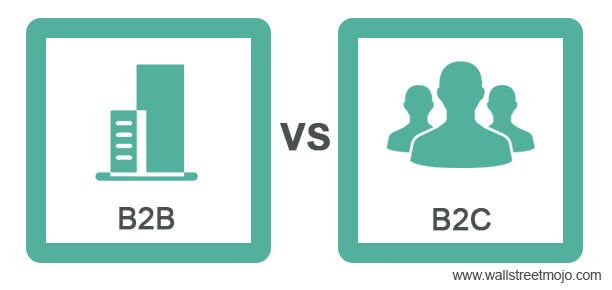Table Of Contents
Difference Between B2B and B2C
In B2B vs B2C, B2B stands for business-to-business, and B2C stands for business-to-consumer. The primary difference between B2B and B2C is that in B2B, the business transaction occurs between businesses or companies. In contrast, a B2C transaction occurs between a business and an individual consumer. For example, a producer selling their outputs to another producer indicates a B2B business and a retailer selling products to individual consumers indicates a B2C transaction. B2B products involve raw materials, manufactured materials, and component parts and assemblies, and B2C products are majorly final goods.

Key Takeaways
- B2B vs B2C explains that B2B stands for business-to-business and transaction occurs between businesses,
- whereas B2C means business-to-consumers, the transaction happens between business and individual consumers.
- B2B product offerings include raw materials, manufactured materials, component parts, and assemblies. B2B buyers are producers, resellers, governments, and institutions.
- The B2C model produces final goods or consumer goods that satisfy human needs and wants.
- B2B vs B2C examples: Payroll processing companies are examples of the B2B model because such companies provide payroll services to other companies.
- Restaurant chains are examples of the B2C model because their customers are individual consumers like households.
B2B vs B2C - Comparative Table
| Particular | B2B | B2C |
|---|---|---|
| Definition | B2B is business-to-business, and the transaction occurs between businesses or companies. | B2C means business-to-consumer, and the transaction occurs between business entity and consumer. |
| End-user | Other businesses or companies buy offerings for their work-related activities. | Individual consumers buy the offerings to satisfy their needs and wants. |
| Offerings | Raw materials, manufactured materials, component parts, assemblies, etc. | Final goods or consumer goods. |
| Aim | To provide other businesses with their work-related products and services. | To provide products and services satisfying human needs and wants. |
| Focus | Focus on building strong and good business relationships. | Focus on building a strong customer base. |
| Function | A firm sells its products or services to another firm. | A firm sells its product or services to individual consumers. |
| Size | The size of an order will be large. | The size of an order will be small. |
| Example | Payroll processing companies | Restaurant chains |
What is B2B?
The B2B business model portrays a commercial relationship between businesses. The dependence between companies or businesses leads to strong and good business relationships contributing to the successful growth of the entities involved. An example of an organization operating strictly on a B2B business model includes a company offering banking software solutions and cloud services to a bank. Such products and services generally are used by banks and financial institutions only.
The producers or manufacturers offer capital equipment, raw materials, original equipment manufacturer (OEM) components, maintenance, repair, and operations (MRO) items, facilitating services, etc., to the business buyers. Business buyers purchase these items to produce or develop their offerings. Examples of business or B2B buyers are producers, resellers, governments, and institutions. In the B2B model, a single order contains a large number of goods or services.
What is B2C?
In the B2C model, the clients of a business entity or a company are the individual consumers who are the end-users. The end-users or the retail customers won't further process the purchases; they consume the things they buy to satisfy their needs and wants. Retail businesses directly sell their offerings to the end consumers. It can be online or offline examples include clothing, grocery, drugs, and restaurants. In a B2C model, businesses spend a significant budget on marketing, advertising, and merchandising to create strong brand recognition, value, and goodwill because it is important in the B2C model to build a good customer base.
Consider an example of B2C in the B2B vs B2C construct. A patisserie sells cakes and pastries to customers who walk into the patisserie or call for home delivery. Here, the patisserie is the business; the consumers are the households, residents, students, etc., and no other businesses are involved between the patisserie and the buyers. Furthermore, the patisserie can attract more customers by strengthening the aroma, offering free samples, focusing on décor and packaging, etc.
A company can have its B2B and B2C segments to serve different customers in the market. For example, a bank offering a salary account to a company for all its employees is an example of a B2B relationship. At the same time, the bank also has retail customers (retail banking) that are part of their B2C segment and offer salary accounts to a company. When companies incorporate B2B and B2C models, they have to follow different procedures in many events for both segments. Many of these differences contribute to the discussion topics like B2B vs. B2C sales and B2B vs B2C ecommerce.
B2B vs. B2C - Video Explanation
B2B vs B2C - Infographics

Similarities
- Both require investing in marketing and advertising. However, the optimum marketing techniques may differ for B2B and B2C, reflecting the relevance of interpretation of B2B vs B2C marketing. For example, a B2B SEO strategy will look very different to one built for a direct-to-consumer business, because you're targeting very
different people. - Good customer service and a customer-centric sales process are significant in both models.
- Both require digital presence.
- A single company can operate in B2B and B2C segments, catering to a diverse customer base.
- Products or service offerings are one of the prime elements in the relationship in both cases.
- Each model creates value.
- Brand image is an essential element in both models.
- Both models can have online and offline sales.
- Both models can have online and offline sales.
- B2B and B2C full form point to the fact that both models contain a business entity. Also, both have buyer and seller entities.

